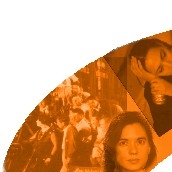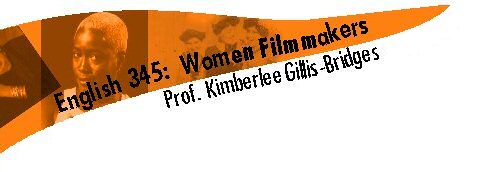


 |
 |
 |
 |
 |
| Course M-TH, 12:00-2:10 More 225 |
| Instructor K. Gillis-Bridges Padelford A305 543-4892 MW, 11:00-11:50 and by appointment |
| Page last updated 7/17/03 |

Essay #2: Comparison and Contrast
Length and Due Date
Length: 5-6 pages, formatted as described in the “Essays” portion of the syllabus
Due Date: Wednesday, July 23, by noon in hard copy at Padelford A-305 or via E-Submit
Assignment
For the essay, you will compare and contrast two films, writing on one of the following topics. In your essay, you will present an argument about the significance of the films’ connections, and you will develop this argument by analyzing the thematic, ideological, narrative, contextual and/or formal elements (setting, costume, lighting, shots, editing, sound, etc.) of both films.
1) How do any two of the following films explore the notion of gender as performance: Blue Steel, Clueless or Boys Don’t Cry?
2) How do any two of the following films construct history: The Watermelon Woman, Illusions, or Boys Don’t Cry?
3) How do any two of the following films examine the tension between protagonists existing as wielders of the gaze versus objects of the gaze: Blue Steel, Clueless, Illusions, or Boys Don’t Cry?
4) How do any two of the following films critique and/or offer alternatives to dominant representations of race, gender, and/or sexuality: Blue Steel, Clueless, The Watermelon Woman, Illusions, or Boys Don’t Cry?
5) How do any two of the following films represent class as a significant element of identity: Blue Steel, Clueless,The Watermelon Woman, and Boys Don’t Cry?
Guidelines
1) Although I have provided questions, you will need to develop an angle of comparison/contrast. For example, one could approach the “critique and/or alternative” question in terms of critique, alternatives, or both. One could choose to focus solely on gender, or one could look at the intersection of gender and race.
2) Effective comparison/contrast essays highlight how similarities and differences reveal something important about each film, the theme, or the filmmaker(s). As you develop your essay, consider how each film “unlocks” the other. Ask yourself why it is important to examine these films together in relation to the theme.
3) Rather than offering a catalogue of your observations regarding the films’ similarities and differences, your essay should pose an argument about the significance of the connection. Your thesis should not simply state that “films X and Y treat theme Z similarly and differently.”
4) While you can organize your comparison/contrast essay in several ways, you should avoid discussing one film in full, then turning to the other. This format relegates the comparison/contrast to the second half of the paper. Instead, you can structure the first part of the body around similarities, moving from one film to the other, and the second part around differences, discussing each film in turn. You can also focus each paragraph on one similarity or difference, discussing examples from both films.
5) Although the comparison/contrast essay examines a large-scale theme, close textual analysis will serve as your main source of evidence. In supporting your argument, you will need to pay attention to how the films address the topic through narrative and/or cinematic techniques. Focus on specific shots or scenes and the cinematic codes at work in those shots or scenes.
6) Remember that you are writing to an audience who has already viewed the films. Therefore, your essay should not offer plot summaries. Instead, any reference to the films—dialogue quotations, scene descriptions, explanations of narrative movement—should support your analysis.
7) Do not forget the rich discussion that has taken place on the electronic bulletin board. A review of the postings on a particular film may help you to ask key questions and shape your analysis.
8) If you’re having difficulty devising an approach to the essay, or if you want to discuss ideas-in-progress, come to my office hours in Padeford A305 or Stefanie’s office hours in Padelford A 11A. You can also email us to set up an appointment. My email is kgb@u.washington.edu; Stefanie’s is stmartin@u.washington.edu.
Grading
Follow this link to view the grading rubric I will use to evaluate the essay. Late essays will receive a 10-point deduction per day late, including weekends. I will not accept Essay 2 responses submitted after July 25. I will make exceptions to the lateness policy only in cases of documented illness or family emergency.